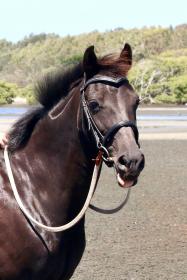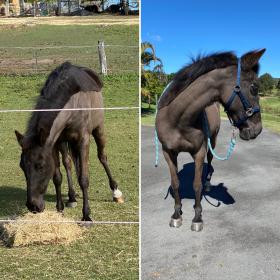Horse is a pony of unknown breeding, approx 20 years old. Lowest (basically zero!) maintenance horse ever, only real issue in her history in the 11 years I’ve had her was one acute laminitis episode in 2016, cause unknown, from which she recovered fully, went back into full work etc. She has been ridden somewhat sproadically for the last couple years, but for most of this year it was 2-4 times a week, mostly flatwork and trails with the odd jumping session. No signs anything was wrong, she appeared happy and sound and our last ride was July 11th, lots of galloping etc and had a blast.
Weekend before last I thought she was a little off, wasn’t keen on having her feet trimmed which I chalked up to her having an off day. I didn’t have time to ride so have her a quick lunge and she looked ok, maybe a tad stiff but it’s the middle of winter here and it was fairly early in the day.
Fast forward to Saturday and she’s struggling to balance while I’m picking out her feet. On the lunge there was a very noticeable issue which gave the appearance of her right hip dipping down and under with every stride. Cantering was a no go, and normally she is more than willing on that front. Called the vet and their preliminary diagnosis is one of the following:
- Trauma from injury, likely a fall. Whilst this is not impossible, I would be genuinely astounded if she had. She’s as sure footed as they come and not once have I seen her even come close regardless of how much she is hooning. There is also no clear indication this is the case, no marks, bumps, swelling, heat etc.
- Spinal degeneration/neurological
Essentially she doesn’t seem to know where her back legs are. She was standing with her left hind way out to the side and the right hind too far underneath her.
Initial treatment has been a week of bute and confined to a smaller paddock (lives out 24/7, stall not an option). As of today (day 4) there is definitely improvement, she’s standing straighter and moving a bit better.
This is a totally foreign issue to me, and based on her health and fitness not something I was expecting to encounter! I’ve already told my vet on the basis of her age I’m not interested in going down the diagnostic rabbit hole, my priority is more whether or not she is able to be kept comfortable and safe in her paddocks. She would not cope with long term confinement. Being able to still jump on and plod around would be great but at 20, if retirement is the case then so be it.
Has anyone experience such similar issues, and what was the end result?



 She appears happy enough in the paddock, but is unable to remain balanced on three legs for any period of time. I can pick her feet out, trimming the fronts is doable but very difficult. Trimming the backs is impossible, and bordering on dangerous to attempt, she’s nearly stepped on me a couple of times. Will be getting the vet back out and requesting my preferred vet who knows her history to see where we go from here.
She appears happy enough in the paddock, but is unable to remain balanced on three legs for any period of time. I can pick her feet out, trimming the fronts is doable but very difficult. Trimming the backs is impossible, and bordering on dangerous to attempt, she’s nearly stepped on me a couple of times. Will be getting the vet back out and requesting my preferred vet who knows her history to see where we go from here.